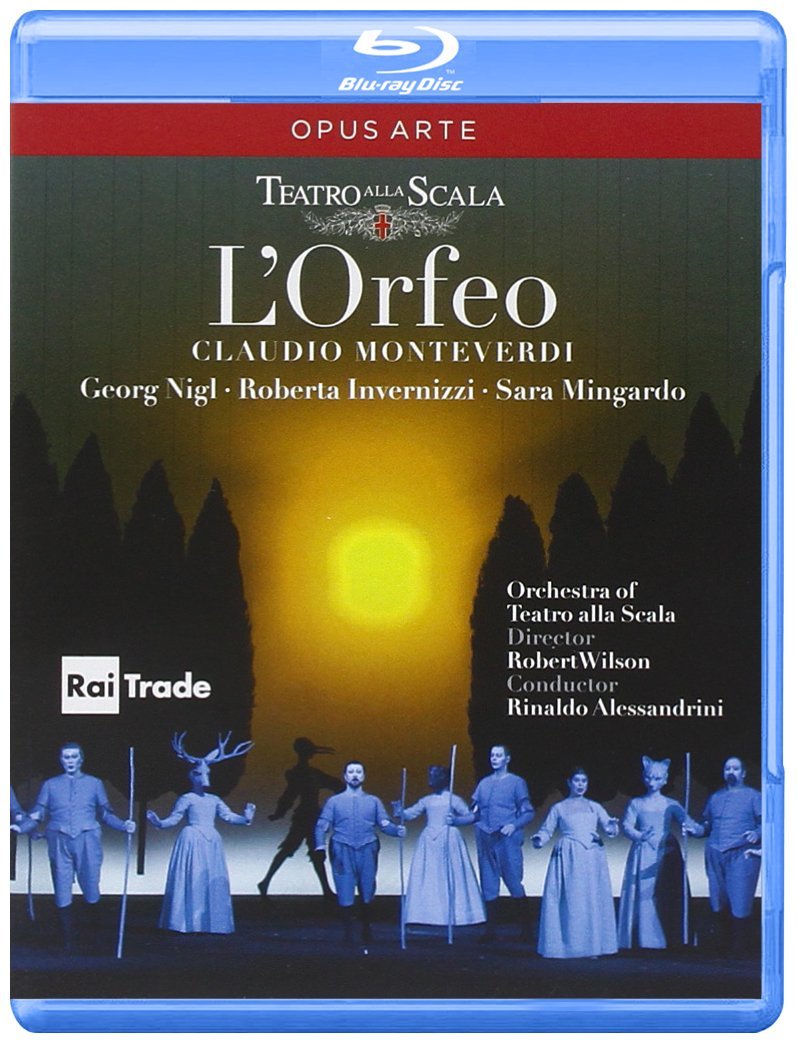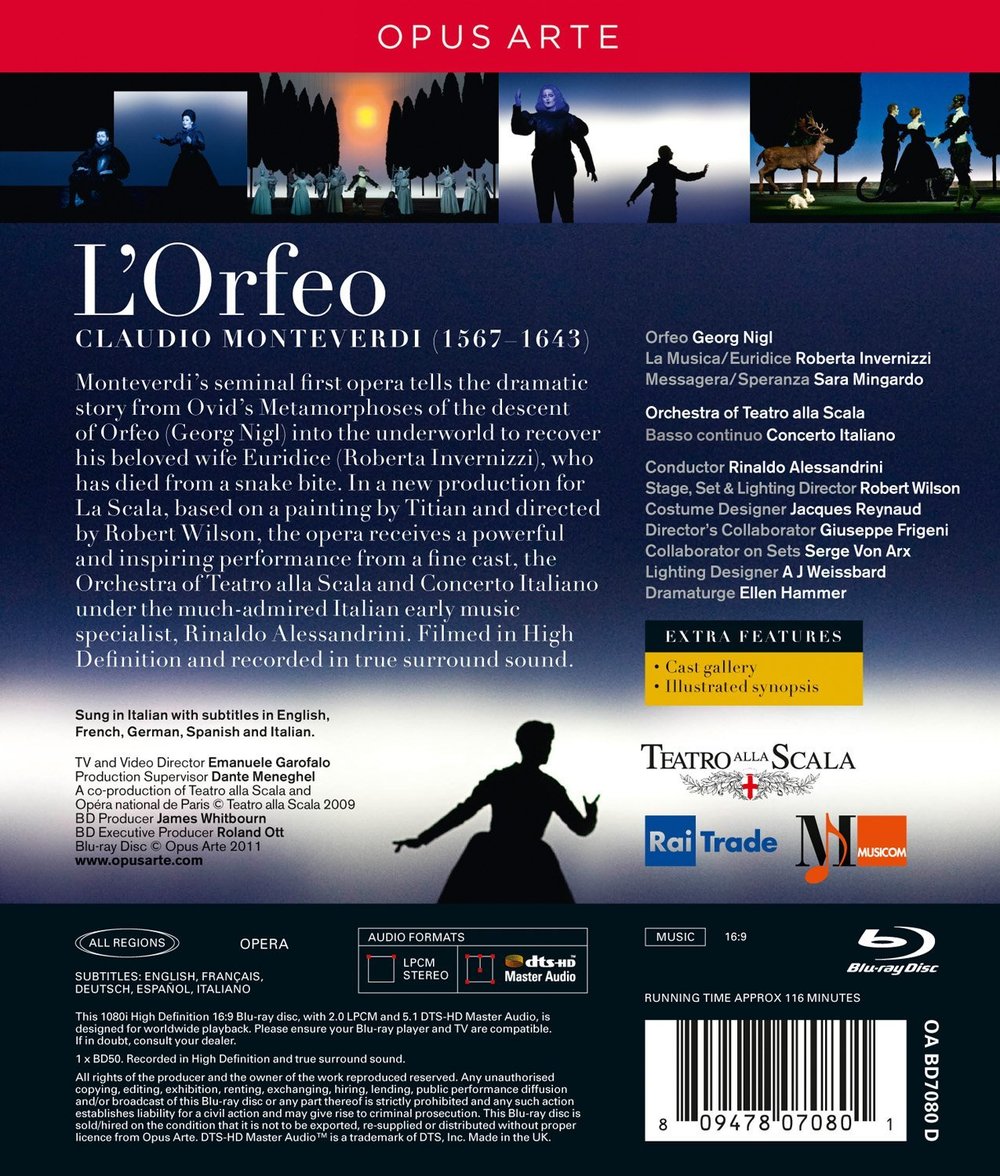

Monteverdi L'Orfeo opera to a libretto by Alessandro Striggio. Directed 2009 by Robert Wilson at La Teatro alla Scala. Stars Georg Nigl (Orfeo), Roberta Invernizzi (La Musica/Euridice), Sara Mingardo (Messenger/Goddess of Hope), Luigi De Donato (Charon), Raffaella Milanesi (Persephone), Giovanni Battista Parodi (Hades), Furio Zanasi (Apollo), Eleonora Contucci, Anna Simboli, Martin Oro, Leonardo Cortellazzi, Luca Dordolo, Gianluca Ferrarini, Marco Scavazza, Matteo Bellotto, and Sergio Foresti (Chorus of Nymphs, Shepherds, and Spirits), as well as dancer Nicola Strada as a bird. Rinaldo Alessandrini conducts the Orchestra of Teatro alla Scala. Basso continuo by Concerto Italinano. Set and lighting design by Robert Wilson; costume design by Jacques Reynaud; lighting design by A J Weissbard; dramaturgy by Ellen Hammer; director's collaboration by Giuseppe Frigeni; set collaboration by Serge Von Arx. Directed for TV direction by Emanuele Garofalo; photography directed by Riccardo De Poli and edited by Carlo Bertucci; sound by Gabriele Fanchini. Sung in Italian. Released 2011, disc has 5.1 dts-HD Master Audio sound. Grade: B+
This L'Orfeo was first performed in 1607 (about the time that Shakespeare finished writing Macbeth). According to the Grove Book of Operas, it was performed occasionally until about 1650 and was thereafter forgotten for 250+ years, until musical historians revived it for a modern performance in 1911! It's generally considered, I think, to be the earliest important opera that survived to be performed in our time.
(The Monteverdi L'Orfeo should not be confused with the several versions of the Gluck opera Orfeo ed Euridice, which is based on the same myth. Gluck wrote his Orfeo opera about the time of the American Revolution in 1776. The Gluck opera is well known, and this is the music most people think of when they hear the name Orpheus.)
I have no doubt that all the singers cast by Robert Wilson do a commendable job that would be praised by early music experts. To me the singing roles sound primitive and monotonous. Other listeners suggest that the simplicity of the vocals gives the music a modern sound. The small orchestra appears to have a mix of modern and period instruments (I was especially intrigued by the 4 sackbutts or early trombones). I'm not an early music fan, but even I find the orchestration to be interesting and pleasant. I was especially impressed by the vitality and presence of the recorded sound, which is right at state-of-the-art for a 48kHz/16bit recording. Finally, I'll give Emanuele Garofalo credit for excellent PQ and video content.
But the most interesting aspect of this production is its artificial and exotic "look and feel." Director Wilson created something special with the clever and coordinated use of a grayed-out color palate for the set, costumes, and lighting together with black and white makeup for the singers. The design reminds me of plays I've seen that mimic old motion pictures by rendering everythdoing on stage in black and white (except for the tongues of the actors which stay pink). It also reminds me of white mannequins I recently saw at a Paul Gaultier fashion show. The heads of some of the mannequins had been molded (I think) in the shape of real people (including Gaultier). Tiny devices hung from the ceiling projected motion pictures of the faces of the real people onto their mannequin heads, and the heads would speak to you with a realistic recorded voice. The resulting spectacle was fascinating and weirdly threatening.
Well, the singers in this opera may not be threatening, but they do look weird. It appears you are watching an opera cast with living cadavers. Most of the living dead have a sickly pale gray-green cast or are colored pale gray-blue. Below are 4 screen shots illustrating this distinctive design (the lady in deep gray-blue is the messenger bringing news of the death of Eurydice):
The most striking character is Luigi De Donato in the role of Charon (Caronte). If you saw his image out of context you would think you were looking at a computer-generated action figure:
On the keep case, the statement is made that the design was inspired by a painting by Titian. I looked at all the Titian works listed on Wikipedia and found nothing that seems to fill the bill (other than possibly a Mater Dolorosa from 1550 that is is rendered in gray-green and blue). Perhaps the color scheme was inspired by the morbid theme of the opera. But at the end of the opera, there is a surprise. By this time, you are used to Wilson's chilled-out world. Then suddenly Apollo appears with ruddy cheeks and a deep red sun starts glowing in the sky as life returns to earth.
During the curtain calls and credits, you see that the live audience got a heavy dose of the living-that-look-like-dead. In the home theater, the effect is accentuated with the use of trick photography and maybe even electronic alteration of colors. For sure, the challenging design here makes this a must-have title for anyone with a keen interest in opera costumes, make up, or lighting.
“I usually give anything by Robert Wilson a high grade because he is no fastidious about good quality, which is impressive even if you have no idea what is going on. And maybe I’m biased in his favor because he grew up in Waco, Texas. Waco (near Dallas) has a reputation for being a red-neck cowboy town. As soon as he could, Wilson road the Trailways Bus from Waco to Manhattan and started working in cutting-edge theater. I think he met Philip Glass when Glass was working as a plumber. They both became famous with their Einstein on the Beach, and Wilson has been in demand for opera designs and direction ever since.
I don't think this title will appeal to enough people for it to get an A grade, so I’ll give it a B+. But if anything about this review interests you, this might be an A+ or A+ title for your shelf.
OR





